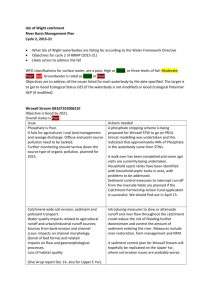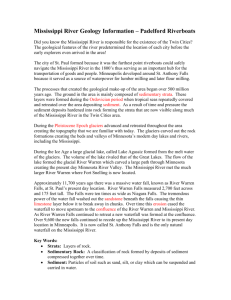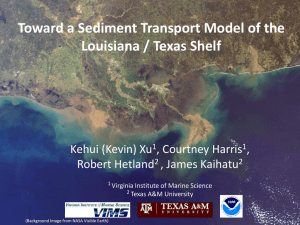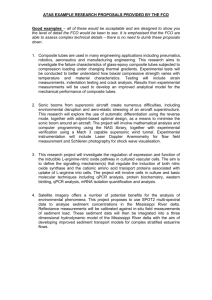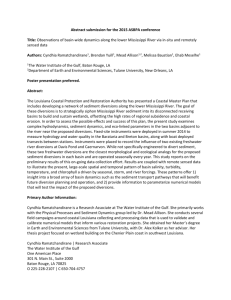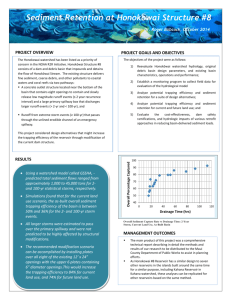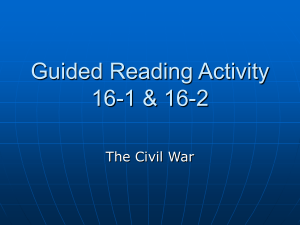l Water and Rivers
advertisement
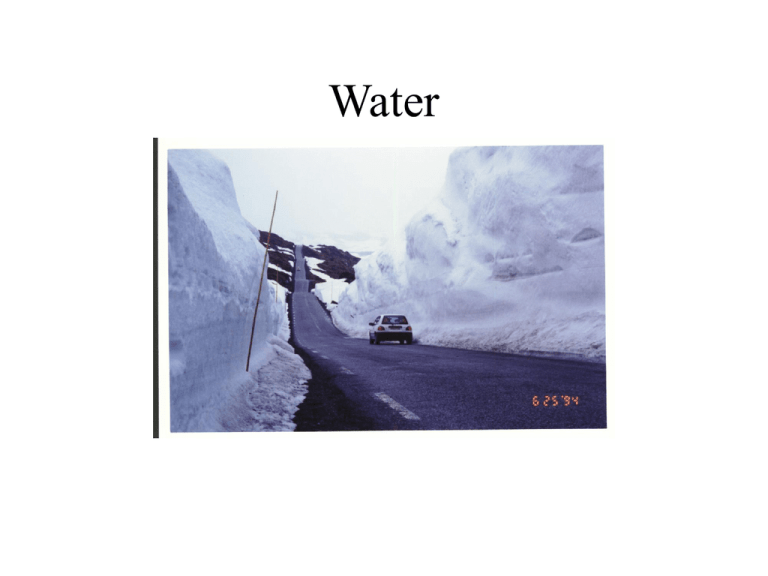
Water Water Distribution Water use in the US in 2000 The Water Cycle Transpiration (plants) Parts of a River Collection Transportation Dispersal Dendritic pattern Yemen Limestone Bedrock: Naturally fractures into squares & rectangles Common in the Appalachians where rivers have cut through parallel ridgelines. Drainage Basin Delta Development Distributary Water coming down a river hits the ocean; gradient goes to zero Sediment is deposited; channel eventually fills River jump its banks and takes a new course Process repeats Very common in deltas Distributaries Mississippi River Delta Mature Deltas Mississippi Delta Left to its own devices, the Mississippi would now be flowing down the Atchafalaya Basin. Oil refineries line the Mississippi Mississippi Embankment Atchafalaya River New Orleans Hurricane Threat -- very real River Dynamics Rivers are complex systems influenced by number of things, which are: - discharge - velocity - gradient - sediment load - base level Stream Discharge - amount of water passing by a given point during a specific time interval - measured in cubic meters/second Discharge Station Velocity Meanders Cut Bank Meandering Oxbow Lakes NE/SD border Slope - fine particles are moved in suspension, never touching the ground (suspended load) - silt & clay giving the water a muddy look - coarse particles are moved by traction along the stream bed, jumping along (bed load) - move by saltation: short leaps as a strong current picks them up and moves them a short distance. - 7-10% of the total sediment load, on average. - abrasion between particles causing them to wear, smoothing them and forming round pebbles and stones. - also wears away the stream channel along the sides and bottom of the channel. - dissolved materials are carried along in solution (dissolved load) - invisible chemical ions Sediment Load QuickTime™ and a Sorenson Video decompressor are needed to see this picture. Mississippi Sediment Base Level The lowest elevation (depth) to which a river can erode its bed. Stream Maturity Youthful Mature Old Age Old Age River Flooded River Levees occur when active deposition takes place along the banks of an older river when it is in a flood. Each time this happens the banks get higher forming a natural levee -- a barrier to future flooding. Natural Levee Levees River channel Urban Runoff More pavement = dramatically increased runoff rates Levee If the river doesn’t flood, sediment is deposited on the river bed; causes water level to rise Concrete Paving Smooth bottom = less friction = fast-moving water = less sediment deposition Levee Breech Siltation Wastewater 15,000,000 people. All pavement. 50 inches of precipitation per year. Where does all the water go? Urban sewer system Many urban sewer systems are outdated Wilmington, Delaware Delaware Streams Storm Sewer Runoff Storm Sewer Runoff Raw untreated sewage KMEG News: Storm Lake, IA “IOWA'S BEACHES WILL STAY OPEN THIS YEAR.EVEN IF THEY *ARE* POLLUTED WITH FECAL BACTERIA.THE IOWA DEPARTMENT OF NATURAL RESOURCES SAYS THE BEACHES AT STATE PARKS ARE TOO POPULAR AND VALUABLE TO IOWANS TO CLOSE THEM WHEN THERE ISN'T CLEAR EVIDENCE OF A HEALTH RISK.LAST YEAR, EMERSON BAY IN LAKE OKOBOJI WAS ONE OF SEVERAL BEACHES CLOSED.THE D-N-R SAYS THIS YEAR THE STATE WILL POST WARNING SIGNS INSTEAD.WORKERS WILL BASE THEIR FINDINGS ONLY ON TESTS FOR FECAL COLIFORM BACTERIA.LAST YEAR, THE STATE CONSIDERED THREE DIFFERENT BACTERIAS.THE D-N-R SAYS IT CONSULTED HEALTH OFFICIALS BEFORE DECIDING THAT USING THREE WAS CONFUSING AND CUMBERSOME.” Alesund, Norway Wastewater Treatment Toxic Runoff Acid Drainage Summitville, CO: All aquatic life absent for 17 miles away from mine. How bad is it?

